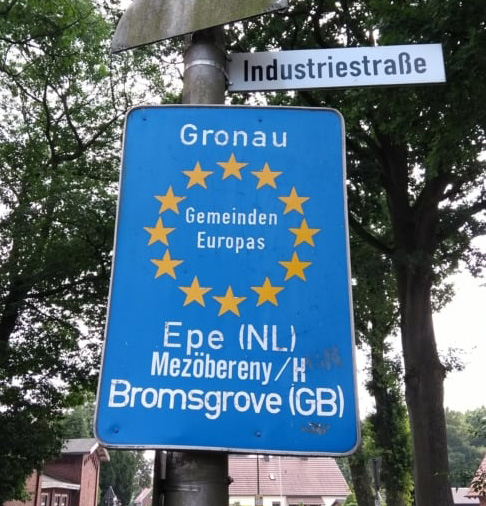There is no European electorate. When voters elect the European Parliament, they vote for their own parties in their own countries. Many want this to change, but existing reform proposals are not sufficient. Matthijs Bogaards proposes twinning. It works to connect local communities across Europe, and it may provide a new way to elect the European Parliament
When entering a European village, town, or city, it is common to see a sign by the side of the road that not only has the name of the place but also a list of sister cities or twin towns.
For example, Dutch Lopik is partners with Lezoux (France), Grebenstein (Germany), and Sarsina (Italy). The West-Swedish community of Mark partners with Apolda (Germany), Ontinyent (Spain), and Szamotuly (Poland).
It will come as no surprise that there is a Council of European Municipalities and Communities or that it has a programme to promote 'twinning'. There is even a European town-twinning association with one partner from each member state. Named after the number of original partners, this Douzelage steadily increased its size with every wave of enlargement. It has now grown to 28 (at the time of writing, British Sherborne is still on the list).
Twinning forges connections that contrast starkly with the way the European Parliament (EP) is elected. Ever since the first direct elections in 1979, EP elections have been organised by member states according to national rules. They are contested by national parties and candidates, who campaign on national issues. Some progress has been made towards harmonising the rules but, paradoxically, European elections remain national affairs.

The European Town Twinning Association aims to 'establish ... educational, economic, tourist, sporting and cultural links between towns for the mutual benefit of the inhabitants'
There is widespread dissatisfaction about the lack of genuine European parties. For many observers, EU democratisation is not possible without a European party system, and that, in turn, depends on electoral reform.
The most radical reform proposal discussed in the EP so far seeks to establish an additional supranational district. There is no agreement on how many Members of European Parliament (MEPs) should be elected in this EU-wide district, but in all proposals, it is a (small) minority. Nonetheless, its proponents expect a transformative effect.
the proposal for a supranational district focuses only on connecting voters to Brussels/Strasbourg. But what about linking citizens in one member state to another?
However, even if the entire EP were elected in a single-EU wide district, problems remain. First, its sheer size would create problems of geographical linkage, increasing the distance between voters and MEPs. Second, voters would likely remain motivated by national considerations. Finally, such reform wouldn't necessarily strengthen Europe-wide parties. The latest EP report to include an EU-wide district would have allowed lists submitted by national political parties and even movements!
More fundamentally, the supranational district proposal focuses only on vertical linkage, on connecting voters to Brussels/Strasbourg. But what about horizontal linkage – linking citizens in one member state to another?
Having one European electorate would do little to strengthen the connections between European citizens. Voters in different parts of Europe would cast their ballots independently from each other, for their own reasons, unaware of the issues that divide and unite them, even when voting for the same European-level parties. This is where the idea of electoral twinning comes in.
Twinning focuses on horizontal linkages. It works for villages, towns, and cities. It can also work to link electorates, and to create genuine European parties.
There are around 345 million eligible voters and 705 seats in the EP. On this basis, the EP could create 705 electoral districts, with half a million voters each. Now imagine the EU map divided into four quadrants: North-West, North-East, South-West, and South-East. Precise zone boundaries aren't important, but they should be of roughly equal size.
To elect MEPs, districts from each zone would be 'twinned' to create a multi-member cross-national district. In accordance with EU law, the winning candidates should be determined by proportional representation. The smallest cross-national district would have four seats, twinning one district from each of the four European zones, but larger districts could easily be created.
Candidates would have to appeal not only to the electorate in their home constituency, but to voters in four locations across the EU
The behaviour of parties, candidates, and voters in such a cross-national district would be very different from what it is now. Parties would have to campaign on issues relevant across the EU, fielding candidates with appeal beyond the local.
Only European parties would be able to run campaigns simultaneously in different corners of Europe. But they couldn't do so without a strong presence on the ground. Candidates could not win by attracting only narrow support from their home constituency. They would have to appeal to voters from across the EU, not in an abstract sense, but concretely, to voters in four specific locations.
Voters would realise that they are electing their MEPs together with citizens from three other places in the EU. They would share their MEPs with fellow Europeans in a concrete, not an abstract sense.
The mission of the European town twinning association is 'to promote and foster the spirit of Europe and to establish among others educational, economic, tourist, sporting and cultural links between the towns for the mutual benefit of the inhabitants thereof'.
Electoral twinning (known in political science as 'constituency pooling') shares that spirit and works in much the same way. It would allow the citizens of Lopik, Lezoux, Grebenstein, and Sarsina, as well as the citizens of Apolda, Ontinyent, Mark, and Szamotuly, to elect their MEPs together.
Together, they would create a horizontally integrated European electorate that strengthens European democracy.